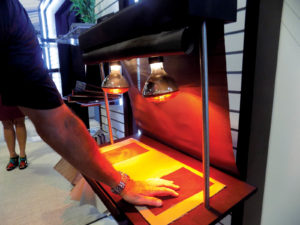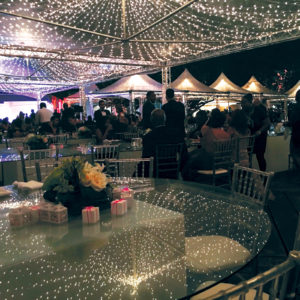
Since the earliest days of civilization, women have sewn garments, constructed the tents they called home, and woven the textiles that made life more comfortable and defined distinctive cultures. Over the millennia, textiles produced by women have been essential to life and enterprise. As industrialization made these goods profitable, however, the textile world became a male-dominated realm. That is starting to change.
We spoke to some of the industry’s talented female leaders and found that women are thriving in the textile business. The creative skills needed for modern textile design, production, construction, sales and business leadership come naturally to these women, and the future of the industry is being shaped by their efforts as well as those of their male counterparts. The rate of change is increasing, and the impetus toward excellence is keeping pace.
Entry levels
Some of our sources knew they wanted to work in this field early on. Patti Bates, general manager at Glen Raven’s technical fabrics division, majored in textiles in college and interned at Glen Raven, the company at which she would eventually spend most of her career. Clare King, owner and CEO of Propel LLC, pursued an entirely different education—in economics—but after graduate school, she began taking classes for fun at the Parsons School of Design, and realized that her hobby was working toward becoming her career. Cheryl Quattlebaum, a plant chemist with Twitchell Technical Products LLC in Dothan, Ala., who works to incorporate technology into new or enhanced fabrics, pursued an education in science and began her career in plastic additives manufacturing. She takes a special interest in developing materials that are more environmentally friendly. Quattlebaum initially approached textiles from the perspective of scientific inquiry and research and development, but was quickly won over by the practical end product. “I remember my first tour through Twitchell,” she says. “I was totally amazed and in awe at the different colored yarns, the looms and the knitting machines.”

Possibly the most common way women come into the industry, however, is through a family business. “I have been doing this work since I was 10 years old,” says Michele Quadri Butterfield, owner of Al’s Awning Shop Inc. in Erie, Pa. She’s not exaggerating: Butterfield is the third-generation owner of the business her grandparents founded, and she grew up in the family shop, designing boat covers and awnings in her teens. “On weekends, it was fun to come to work with my dad. I learned quickly that if we wanted to join him, we had to get up early or I’d be left behind. My grandmother always had treats for me there and I loved the family atmosphere. I started working on client repairs and small items, and by the time I was in my mid-teens, I was working directly with the clients.”
Despite this apprenticeship, Butterfield didn’t plan to follow in her father’s footsteps. After he passed away, however, she earned a degree in business management and came back home to take over the shop. The lessons she learned with her family—about hard work, attention to detail and attentive customer service—carried the shop forward, and her education helped Butterfield keep the company nimble in changing times. By staying attuned to product and design trends and moving into more complex architectural applications, Al’s Awning Shop has quadrupled in size under Butterfield’s guidance.
Kate Mitchell, owner of Mitchell’s Marine Canvas, known today as NOMAR, initially resisted the family business. In 1941, her mother, Ruby Kent, was the first woman in Washington state to get her journeyman card as an upholsterer. “I grew up under those sawhorses sitting in the middle of the front room,” says Mitchell, who thought, “No, that isn’t what I am going to do.” When necessity called, however, she admitted she had a very useful skill. After she and her husband moved to Alaska, she found that the fishing industry needed a range of textile products, from boat covers to specialty Brailer bags (smooth-sided bags designed to transport salmon without marking the fish) she designed for commercial anglers.
“I slowly discovered how much I enjoyed the business of creating usable things and being part of a community. In the beginning, I could do this for a little extra money to help my family, in our front room, and raise my own kids. It slowly evolved into a full-time, year-round production and custom shop with 16 full-time employees,” she says.

Suzanne Warner, vice president of Tentnology®, headquartered in Vancouver, B.C., Canada, also got into the industry through family—in a different way. “I married the owner!” she says. Thirty years ago, the tent rental business was in its infancy, and Jack Warner had a new cross-cabled peaked party tent design. Suzanne, who came from a retail and cosmetics background, knew she could take it places. “As a woman, I knew the end user would love it, because it was beautiful and different,” she says. “It was a really innovative design at the time.”
At trade shows, she noticed that most of the other women were wives or daughters rather than industry professionals, but Warner knew the Tentnology product would catch on when she saw how those women reacted to it. Her insights into the audience, combined with her solid understanding of the engineering behind the company’s artistic tent structures, helped the company grow and evolve. Today, Tentnology creates tents for weddings, celebrity events and different architectural purposes around the world.
Getting the job done
The reality? We can’t say that the textile industry doesn’t have its share of sexist attitudes and behaviors. “I have faced some challenges, but I think they have made me more determined to succeed,” says Quattlebaum. “I look forward, work hard, and focus on my work.” The professionals we spoke with say they have found success by picking their battles and letting their good work speak for itself. Unless they don’t get the chance to prove themselves, that is.
King’s business is staffed entirely by women, with the exception of one retired military officer in her business development department. That led one company in the medical industry to dismiss Propel entirely. “Word came back that there wasn’t enough testosterone in our business,” she says. “I thought that was so childish. It’s a pity for them, as we are engineering some electrically enabled textiles that will have great utility in the medical applications. If people are going to dismiss me based on gender, then they are ignoring my skills and experience. And we live and breathe by the success of our products. They get the job done.”

Butterfield admits that some of the men in the construction and architecture fields don’t accept her expertise at first, and with her early start, she has nearly four decades of experience. “Constructing things with fabric is different than building with wood or metal, and sometimes they will just come in and say, ‘Here’s what I want,’ and I know that it won’t work. When it’s their project, not all men will accept advice from a woman, but I need to give them an end product that will function and look right.”
It turns out that one way to bridge the divide is through education. Butterfield teaches the principles of fabric structures in an IFAI course that earns architects continuous education credits with the American Institute of Architects. She finds that in a theoretical environment, rather than in the field, she’s listened to as an authority and is able to make a difference in the way textile and building professionals perceive each other—to the ultimate success of their shared goals.
Patti Bates makes a difference by mentoring young women in the industry. When she started her career, there were very few women in management and, therefore, no female mentors. “Fortunately, men were very supportive and gave me good advice. I learned never to come to a meeting unprepared, to get my materials together and find my voice,” she says. She started in industrial engineering and also held positions in planning, operations, sales and purchasing before becoming a general manager. There have been frustrating moments along her path, but she tells her mentees to be proactive and come in with a solution, rather than be a complainer. She also tells them to explore as many areas as possible within a company, cultivating a general expertise that makes a person more promotable—advice that will lead to continued growth of women in leadership positions. “Today I see young women in the industry traveling the world, holding very significant jobs and making significant decisions.”
These women in the textile industry stress the importance of developing the expertise that will eliminate any question of who is, or isn’t, qualified to design, cut, measure, craft, sell and engineer textiles and textile products. Back in 1941, when Ruby Kent sat for her journeyman’s union card, 12 men watched her work all day, hoping to intimidate her or find flaws in her work. “Finally, in the end they could not keep her from winning this coveted journeyman ticket,” says Mitchell. “My mom’s words play back often: ‘You can do anything you set your mind to. You just have to outlast those trying to stop you.’”
No matter what role women play in today’s complex textiles industry, our sources told us it’s important for them to take pride in their contributions. “We have the ability to take a roll of materials and turn it into something that has purpose and looks great. We have the creativity. We have the physical strength to manage the project. I can manhandle a large awning,” says Butterfield. “Maybe this is a holdover from when sewing was considered women’s work, and women would rather fight for a man’s job now. But this is real work, and it’s meaningful work, and women should be proud to return to it.”
Amy Goetzman is a freelance writer and editor based in Maplewood, Minn.
 TEXTILES.ORG
TEXTILES.ORG


